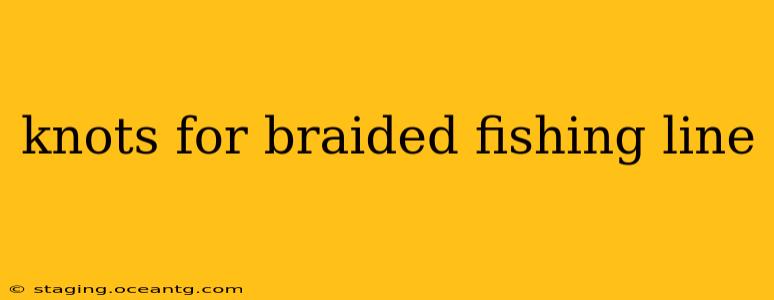Braided fishing line offers incredible strength and sensitivity, making it a popular choice for anglers. However, its smooth, tightly woven structure presents unique challenges when tying knots. Choosing the right knot is crucial for preventing line breakage and ensuring successful fishing trips. This guide explores several reliable knots ideal for braided line, addressing common angler questions along the way.
What are the best knots for braided fishing line?
Several knots consistently prove their effectiveness with braided line. The choice often depends on the specific application – connecting to a lure, joining two lines, or attaching to a swivel. Top contenders include:
- Improved Clinch Knot: A classic and incredibly strong knot, perfect for attaching lures and terminal tackle to braided line. Its simplicity makes it a favorite for anglers of all skill levels.
- Palomar Knot: Another highly reliable choice, known for its strength and ease of tying. It creates a smaller knot profile than the improved clinch, which can be beneficial in smaller guides.
- FG Knot: For connecting two lines of the same or different diameters, the FG knot (Fuji Grip Knot) is a top performer, boasting exceptionally high strength and minimal bulk. It's a more complex knot but worth mastering for its superior performance.
- Albright Knot: Excellent for joining two lines of different diameters, like braided mainline to a fluorocarbon leader. Its strength and reliability make it a popular choice for this specific application.
Remember, proper knot tying technique is paramount. A poorly tied knot, even with the best design, will weaken and potentially fail under pressure. Practice these knots thoroughly to develop confidence and proficiency.
How do I tie knots in braided fishing line that won't slip?
The key to preventing slippage with braided line is to ensure the knot is tightly cinched and all strands are properly interwoven. Here’s what to focus on:
- Wet the line: Before tightening, wet the braided line. This reduces friction and allows for a smoother, more secure knot.
- Proper tension: Apply consistent and even pressure when tightening the knot. Avoid jerking or using excessive force, which can damage the line.
- Multiple passes: For many knots, multiple passes around the line will increase security and strength.
- Use knot tools: Knot tying tools like a knot tying aid or a specialized jig can help ensure a correctly tied, snug knot, especially beneficial for anglers with less dexterity.
What is the strongest knot for braided fishing line?
While there's no single "strongest" knot for all situations, the FG Knot generally ranks high in terms of strength for connecting two lines. The Improved Clinch Knot and Palomar Knot also offer excellent strength when used correctly for attaching lures and terminal tackle. The strength of any knot depends heavily on the execution.
Which knot is best for connecting braided line to fluorocarbon?
For connecting braided line to fluorocarbon leader material, the Albright Knot is a top choice. Its design allows for a secure connection between the two significantly different line types. The FG Knot can also be effective, although slightly more difficult to master for this specific application.
What are the easiest knots for braided fishing line to tie?
The Improved Clinch Knot and Palomar Knot are generally considered the easiest knots to learn and master for attaching lures and terminal tackle to braided line. Their straightforward tying sequences make them ideal for beginners and experienced anglers alike.
How do I prevent braided fishing line from fraying when tying knots?
Braided line's smooth, compact structure makes it less prone to fraying compared to monofilament. However, to minimize any potential fraying:
- Use sharp scissors or line cutters: Avoid dull blades that can crush or damage the line during trimming. Clean cuts reduce the chances of fraying.
- Avoid excessive tightening: Avoid over-tightening the knot, which can weaken and potentially fray the line.
- Use a dab of super glue (optional): For extra security, a small amount of super glue applied to the knot after tightening can help prevent unraveling (ensure the glue is compatible with your line type).
By understanding these knots and techniques, you can confidently use braided line and enjoy its advantages in your fishing adventures. Remember, practice makes perfect; take your time, and with experience, you’ll become proficient in tying strong, reliable knots for your braided fishing line.
